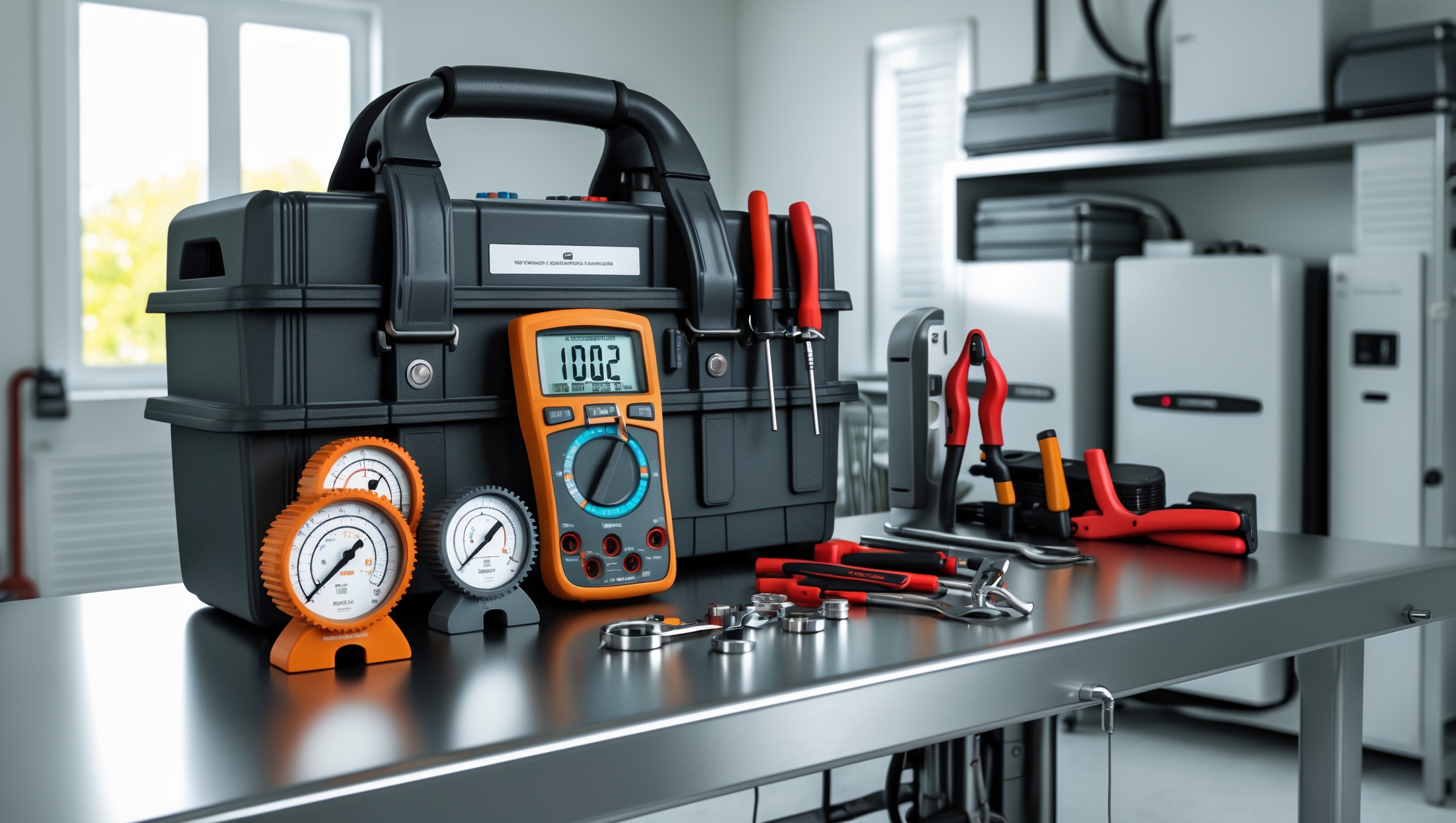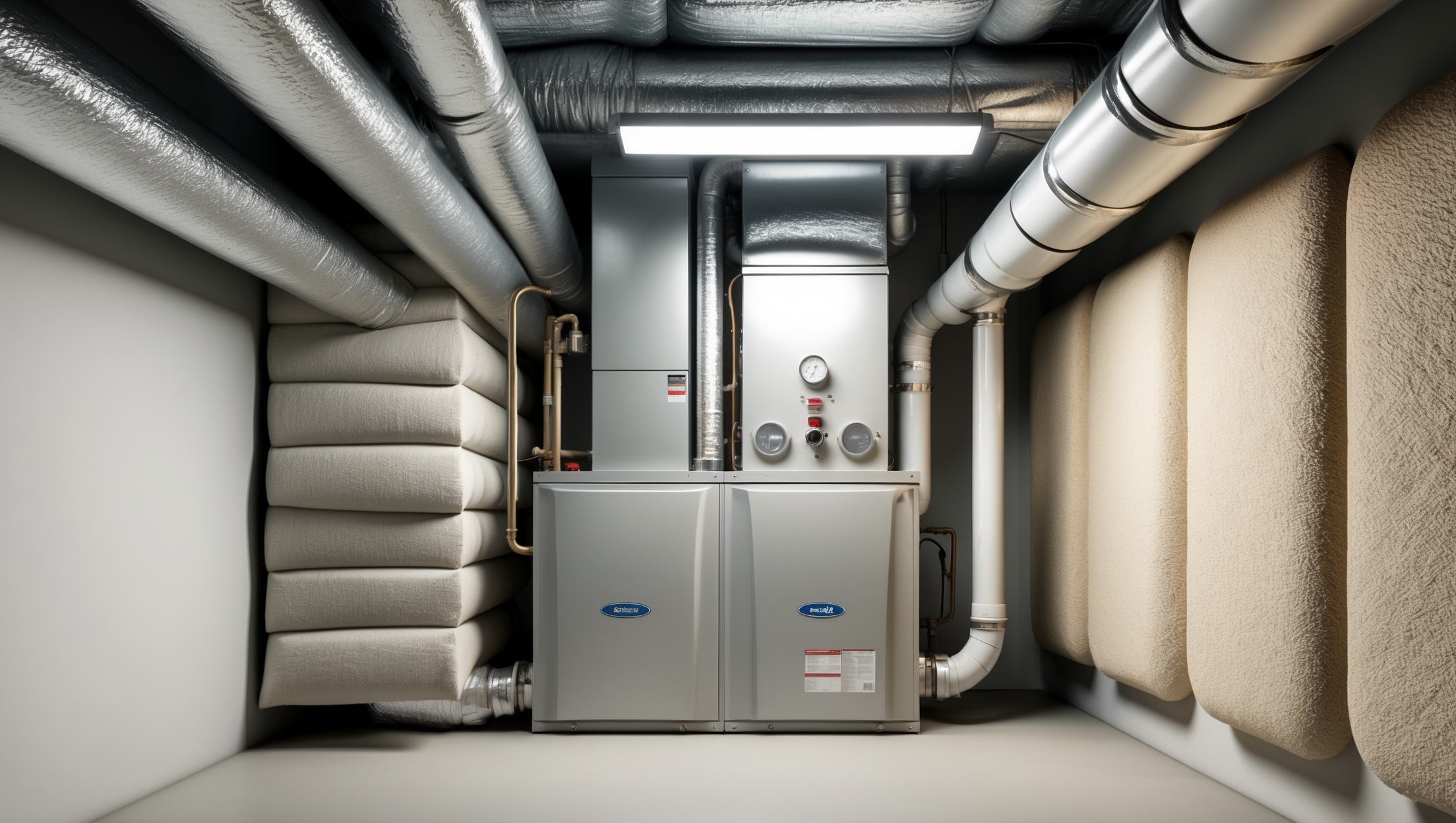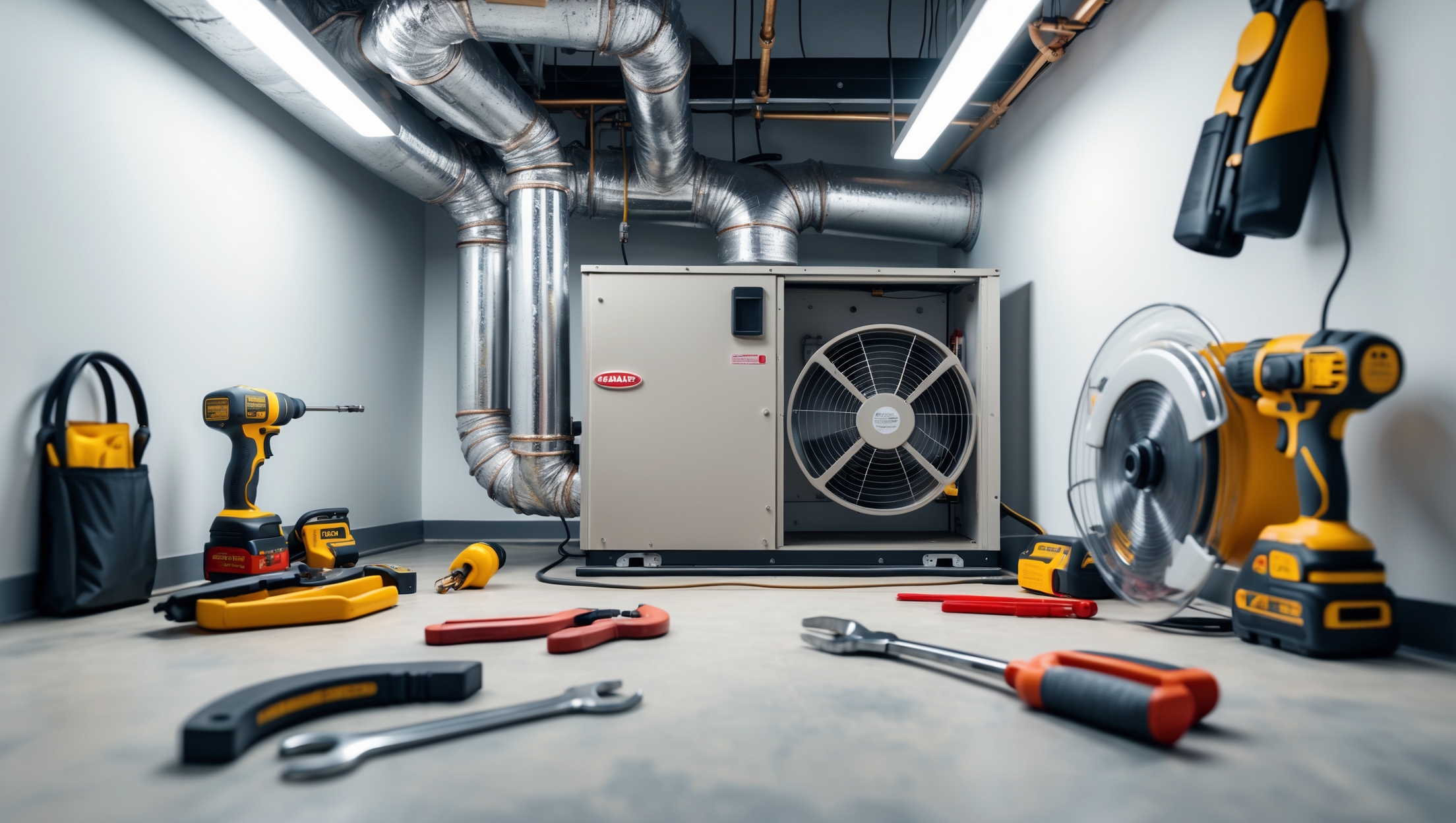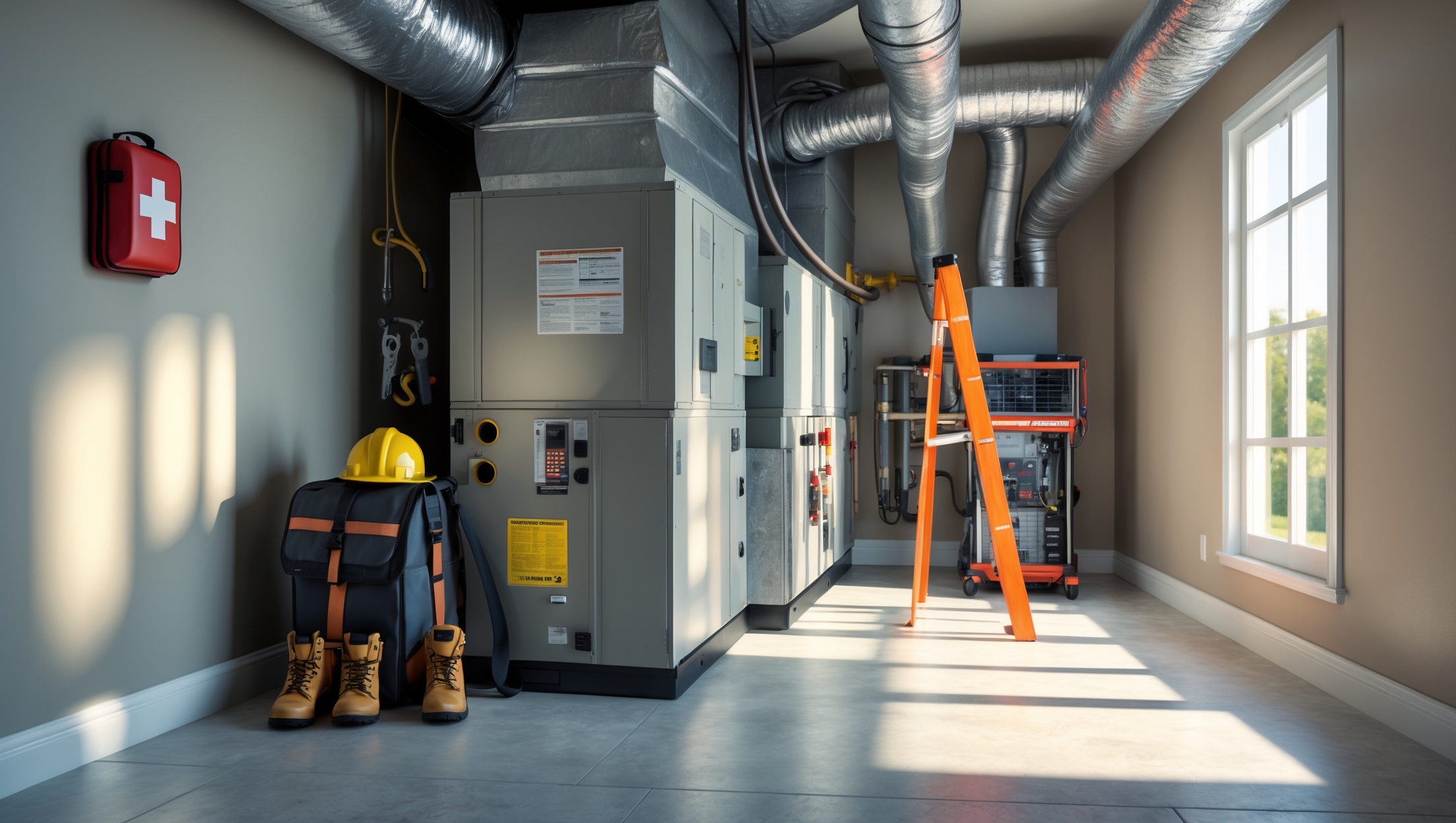Introduction: Why the Right HVAC Tools Matter
Whether you’re a hands-on homeowner, a seasoned contractor, or a property manager overseeing multiple buildings, your approach to HVAC maintenance and repair can make or break your comfort, indoor air quality, and energy costs. But there’s a key factor that often separates smooth, successful projects from frustrating, costly setbacks: having the right tools and equipment. The HVAC field is highly specialized, with tasks ranging from routine filter swaps to complex refrigerant work. Using the proper tools not only ensures efficiency and safety but also helps prevent accidental system damage, costly callbacks, and even voided warranties.
This comprehensive, practical guide demystifies the essential HVAC toolkit for both homeowners and professionals. We’ll break down the must-have tools for routine maintenance, diagnostics, and installations—distinguishing between what’s truly necessary for DIY upkeep and what belongs in a licensed contractor’s arsenal. You’ll learn how investing in the right equipment pays off in saved time, improved safety, and better indoor comfort. Plus, we’ll provide tips for tool care, budgeting, and smart purchasing, so you can build your toolkit with confidence and avoid expensive mistakes. Whether you want to tackle basic tasks yourself or ensure your service provider is properly equipped, this guide is your roadmap to smarter, safer, and more efficient HVAC care.
HVAC Tools 101: Understanding the Basics
Why Specialized Tools Are Non-Negotiable
HVAC systems blend mechanical, electrical, and fluid dynamics. Many tasks—like pressure testing or refrigerant charging—require precision and safety precautions that general tools can’t provide. Using the wrong tool can damage sensitive components, cause system imbalances, or even create safety hazards such as refrigerant leaks or electrical shorts.
Categories of HVAC Tools
- Hand Tools: The backbone of every toolkit, including wrenches, screwdrivers, pliers, and cutters.
- Diagnostic Instruments: Multimeters, manometers, and leak detectors for troubleshooting electrical and system issues.
- Refrigerant Tools: Recovery machines, vacuum pumps, and manifold gauges for safe handling of refrigerants.
- Specialty Tools: Coil cleaners, fin combs, benders, and swaging tools for specific installation or repair tasks.
- Safety Equipment: PPE like gloves, goggles, and respirators to protect against physical, chemical, and electrical hazards.
Must-Have HVAC Tools for Homeowners
Basic Maintenance Toolkit
For routine maintenance and minor repairs, every homeowner should have:
- Phillips and Flathead Screwdrivers: For removing panels and changing filters.
- Adjustable Wrench: Useful for tightening connections and fittings.
- Needle-Nose Pliers: Ideal for accessing tight spaces and manipulating wires.
- Socket Set: For fastener removal on HVAC cabinets and mounting brackets.
- Tape Measure: To check duct sizes, clearances, and replacement part dimensions.
- Flashlight or Headlamp: Essential for inspecting dark corners around air handlers or condensers.
- Shop Vacuum: For clearing dust and debris from vents, drains, and coils.
- Filter Grille Key: For easy access to return air grille filter slots (often overlooked).
Safety Essentials for DIYers
- Work Gloves: Protect your hands from sharp sheet metal and hot surfaces.
- Safety Glasses: Prevent eye injuries from dust, debris, or accidental tool slips.
- Basic Respirator or Dust Mask: Especially important when cleaning ducts or changing filters in dusty environments.
Optional: Entry-Level Diagnostic Tools
For the more adventurous homeowner, consider:
- Infrared Thermometer: Non-contact, quick checks of supply/return temps.
- Basic Digital Multimeter: For verifying power supply to the system (always follow safety protocols—shut off breakers before opening panels).
Essential Tools for HVAC Contractors
Advanced Hand Tools
- Ratcheting Wrenches: Speed up disassembly and reassembly in tight spaces.
- Tube Cutters: For clean copper and PVC pipe cuts.
- Flaring and Swaging Tools: Prepare refrigerant lines for leak-proof connections.
- Basin Wrench: For hard-to-reach fasteners, especially in cramped equipment closets.
Diagnostic Equipment
- Digital Multimeter (True RMS): For safe, accurate electrical testing and troubleshooting.
- Clamp Meter: To measure current draw on compressors, fans, and pumps.
- Manifold Gauge Set: For checking system pressures during charging, evacuation, and diagnostics.
- Combustion Analyzer: Essential for tuning and safety checks on gas furnaces and boilers.
- Carbon Monoxide Detector: Quick checks for hazardous leaks in combustion appliances.
Refrigerant Management Tools
- Vacuum Pump: Removes moisture and air before refrigerant charging.
- Refrigerant Recovery Machine: Safely removes and stores old refrigerant per EPA guidelines.
- Electronic Leak Detector: Pinpoints refrigerant leaks for fast repairs.
- Refrigerant Scale: Ensures precise charging by weight.
Specialty and Installation Tools
- Coil Cleaning Equipment: Sprayers and foaming agents for condenser and evaporator coil maintenance.
- Fin Comb: Straightens bent coil fins to restore airflow and efficiency.
- Benders and Swagers: For custom copper line fabrication.
- Duct Crimper and Seamer: For on-site ductwork modifications.
- Sheet Metal Snips: For cutting new duct openings or patching holes.
Safety and Compliance Gear
- Electrical Lockout Kit: Prevents accidental energization during repairs.
- Insulated Gloves: For electrical safety when working in live panels.
- Respirators (with appropriate filters): For chemical coil cleaning or work in mold-prone areas.
- Ear Protection: For noisy mechanical rooms and equipment.
Tools for Property Managers Overseeing Multiple Units
Streamlining Inspections and Maintenance
If you’re responsible for several residential or commercial units, efficiency is everything. Consider:
- Inspection Camera (Borescope): For remote visual checks inside ducts and equipment.
- Portable Label Printer: To track filter change dates, equipment IDs, and maintenance records directly on-site.
- Moisture Meter: Detects hidden leaks that can damage HVAC systems and property.
- Wireless Data Loggers: Monitor temperature and humidity trends across multiple units for proactive maintenance.
Inventory and Tool Tracking
Reduce loss and improve accountability with:
- Tool Inventory App: Track which technician has which tools and when maintenance is due.
- Lockable, Mobile Tool Carts: Securely transport and store equipment between units or buildings.
Investing Smart: Quality vs. Quantity
When to Buy Premium, When to Save
- Diagnostics: Always invest in high-quality, accurate meters and gauges. Inaccurate readings can lead to expensive mistakes.
- Hand Tools: Mid-range brands often balance durability and price for homeowners. Contractors may benefit from premium brands with lifetime warranties.
- Rental vs. Purchase: For rarely used specialty equipment (like recovery machines or combustion analyzers), renting may be more cost-effective, especially for homeowners or property managers.
Budgeting for Your Toolkit
Start with the essentials and expand as your needs grow. For homeowners, a basic toolkit can be assembled for $100–$200. Contractors should budget $1,000–$3,000 for a robust, professional setup. Factor in costs for calibration, replacement parts, and tool insurance for business owners.
Warranties and Support
- Choose tools from reputable brands with strong warranties and accessible customer support, especially for electronics.
- Keep proof of purchase and register tools when possible for easier warranty claims.
Tool Maintenance: Maximize Lifespan and Performance
Routine Cleaning and Storage
- Wipe down tools after each use to remove dust and chemical residues.
- Store electronics in padded cases, away from moisture and temperature extremes.
- Keep blades and cutting edges sharp and rust-free.
Calibration and Safety Checks
- Schedule annual calibration for digital meters, gauges, and analyzers to ensure accurate readings.
- Inspect cords, batteries, and insulation for wear and replace as needed.
- Test safety devices (lockout kits, detectors) regularly to ensure reliability.
Common Tool Mistakes to Avoid
- Using Non-HVAC Tools: Substituting general tools can result in stripped fittings, inaccurate readings, or equipment damage.
- Skipping Calibration: Out-of-spec gauges or meters can mislead diagnostics and create hazards.
- Neglecting Safety Gear: Underestimating the risks of refrigerants, electricity, or sharp metal can lead to injury.
- Overbuying: Avoid splurging on specialty tools you’ll rarely use—rent or borrow when appropriate.
- Poor Organization: Disorganized toolkits lead to lost time, misplaced parts, and increased jobsite frustration.
Building Your Toolkit: Step-by-Step Setup
Step 1: Assess Your Needs
- Homeowner, contractor, or property manager? List out the tasks you expect to tackle.
- Review your HVAC system types (forced air, mini-split, heat pump, gas furnace, etc.).
Step 2: Start with the Essentials
- Purchase a quality set of basic hand tools and safety gear.
- For contractors, invest early in reliable diagnostic instruments.
Step 3: Expand as Needed
- Add specialty tools as you encounter more complex systems or repairs.
- Rent high-cost or rarely used equipment, especially for one-off projects.
Step 4: Organize for Efficiency
- Use toolboxes, pouches, or carts to keep everything accessible and protected.
- Label and inventory tools to prevent loss and speed up jobsite work.
Step 5: Maintain and Review
- Clean, inspect, and calibrate tools regularly.
- Review your toolkit annually and update as technology and system types evolve.
Conclusion: The Payoff of a Well-Equipped HVAC Toolkit
Whether you approach HVAC from the perspective of a proactive homeowner, a detail-oriented contractor, or a multi-property manager, your toolkit is much more than a box of gadgets—it’s your assurance of comfort, safety, efficiency, and peace of mind. The right tools empower you to maintain indoor air quality, keep energy costs in check, and extend the life of your HVAC systems. For contractors, being properly equipped is also a mark of professionalism that builds client trust and reduces costly callbacks.
Investing in quality tools is an investment in your safety, your property, and your reputation. By focusing on the essentials, maintaining your equipment, and expanding your toolkit thoughtfully, you’ll avoid the frustration of mismatched or poorly performing tools. You’ll also ensure that every inspection, repair, or installation is completed efficiently—and most importantly, safely. In an industry where standards and technology evolve rapidly, staying current with the best tools pays dividends in both performance and confidence.
Whether you’re just starting out or looking to elevate your approach, remember: a well-equipped toolkit is the foundation of energy-smart living, healthy indoor air, and long-term comfort. Take the time to build it right—and reap the benefits for years to come.





When you mention that using the wrong tool can void warranties on HVAC systems, are there common homeowner mistakes I should watch out for that might risk my system’s warranty coverage?
Absolutely, there are a few common mistakes homeowners make that can impact HVAC warranties. Using generic or incompatible parts, attempting DIY repairs without the right tools, or skipping professional maintenance are some of the main risks. Manufacturers often require certified technicians for repairs and specific tools for maintenance, so using the wrong items or unauthorized methods can void your warranty.
When budgeting for a starter toolkit, how much should I expect to invest in the must-have items for routine HVAC upkeep, and are there reliable brands you recommend for someone who only does occasional DIY repairs?
For a basic HVAC starter toolkit focused on routine upkeep, you can expect to spend between $100 and $250. This typically covers essentials like a multimeter, screwdrivers, pliers, an adjustable wrench, and a service thermometer. For occasional DIY use, brands like Klein Tools, Milwaukee, and Stanley are reliable and widely available. Investing in quality basics ensures safety and durability without overspending.
The article mentions budgeting and smart purchasing for HVAC tools. Are there particular brands or features you recommend for someone starting their toolkit, especially to balance cost and long-term reliability?
For those just starting out, consider brands like Klein Tools, Milwaukee, and DeWalt, which are known for their reliability and reasonable prices. Look for features like ergonomic grips, durable materials, and multi-functionality, so you get more value from each tool. Investing in quality on essential items like multimeters, gauges, and screwdrivers will save money in the long run by reducing replacements.
I’m interested in your budgeting tips for building a reliable HVAC toolkit. Could you provide some guidance on prioritizing which tools should be purchased first for someone just starting out, especially if they’re on a limited budget?
When starting out with a limited budget, focus on purchasing essential hand tools first—like screwdrivers, pliers, a sturdy tape measure, and an adjustable wrench. Next, add a reliable multimeter for safety and troubleshooting. As you gain experience or budget allows, consider investing in specialized HVAC tools such as a refrigerant gauge set and leak detector. Building up your toolkit gradually lets you prioritize quality over quantity.
Can you clarify which HVAC maintenance tasks are realistic for a homeowner to tackle with the right tools versus which ones really require a licensed contractor? A checklist or some guidelines would be helpful.
Homeowners can safely handle basic HVAC maintenance like changing air filters, cleaning vents and registers, checking thermostat settings, clearing debris from around outdoor units, and gently cleaning condenser coils. These tasks just need simple tools such as screwdrivers, a vacuum, or a coil brush. Anything involving refrigerant, electrical components, gas lines, or system diagnostics should be left to a licensed contractor. If in doubt, call a professional to avoid safety risks or voiding warranties.
The article separates tools that are essential for DIY upkeep versus those that only professionals should handle. Could you give some examples of tools or tasks where a homeowner should definitely call a licensed contractor instead of attempting it themselves?
Absolutely. Tasks that involve refrigerant handling, like recharging AC systems, or anything requiring electrical rewiring should be left to licensed contractors. Tools such as refrigerant recovery machines, manifold gauges for R410A or R22 systems, and combustion analyzers are best used by professionals. These jobs involve safety risks and legal requirements that go beyond typical homeowner maintenance.
After reading about how the right tools can help avoid voiding warranties, I’m wondering what steps a DIYer should take to make sure any maintenance or repairs they do won’t accidentally affect their system warranty?
To protect your HVAC system warranty when doing DIY maintenance, always check your warranty terms before starting any work, as some require professional servicing. Use only recommended tools and parts, keep detailed records of everything you do, and avoid modifications outside routine maintenance like filter changes. If you’re unsure about a task, it’s safest to consult a licensed technician.
The article mentions that using the wrong tool could void an HVAC system’s warranty. Are there specific tools that homeowners should avoid using themselves to make sure they don’t accidentally void their warranty when doing routine maintenance?
Homeowners should avoid using specialized tools like refrigerant gauges, vacuum pumps, and electrical testers on their HVAC system, as using them without proper training can lead to mistakes or damage that voids the warranty. For routine maintenance, it’s usually safe to stick with basic tools such as a soft brush or vacuum for cleaning, and always check your warranty terms before attempting more advanced tasks.
The article mentions budgeting and smart purchasing for HVAC tools. Are there particular brands or features you recommend for beginners so I don’t overspend but still get reliable equipment for basic upkeep?
For beginners, it’s wise to choose reputable but affordable brands like Klein Tools, Yellow Jacket, or Fieldpiece for basic HVAC hand tools. Look for features such as comfortable grips, clear measurement markings, and durable construction. Starter kits can also offer good value. Avoid the cheapest off-brand tools, as they may not last or perform well, but you don’t need to jump to professional-grade sets right away.
You mentioned that using the wrong tool could void an HVAC system warranty. Can you give examples of specific tools or situations where this happens, especially for homeowners who might be trying some basic maintenance themselves?
Using improper tools, like adjustable wrenches instead of the correct size flare nut wrenches when working on refrigerant lines, can damage connections and void warranties. Homeowners using non-HVAC rated gauges or attempting to recharge refrigerant without certified tools are also at risk. Even simple tasks like replacing filters should be done with recommended tools to avoid damaging components the warranty covers.
I noticed you mentioned that using the wrong tool could lead to voided warranties or safety hazards. For someone just getting started with HVAC maintenance at home, which tasks are truly safe to tackle DIY without risking warranty issues?
For beginners, it’s generally safe to handle simple HVAC tasks like changing air filters, cleaning air vents, and checking thermostat batteries. These tasks won’t affect your warranty or pose safety risks. However, anything involving electrical components, refrigerant, or opening sealed units should be left to professionals to avoid safety hazards and potential warranty voiding.
The article mentions tasks like pressure testing and refrigerant charging needing precision tools. As someone new to this, is there a way to tell when a job is safe for a DIYer versus when I really need to call a licensed contractor to avoid safety or legal issues?
Tasks such as pressure testing and refrigerant charging often require specialized tools and a solid understanding of HVAC systems, as mistakes can lead to safety risks or legal violations. Generally, simpler jobs like changing filters or cleaning vents are safe for DIY, but anything involving refrigerants, electrical wiring, or pressurized systems is best left to licensed professionals. If you’re unsure or the task involves chemicals or high voltage, it’s safest to call a contractor.
The article points out that tasks like refrigerant charging are better left to licensed contractors. Are there any clear signs or symptoms that indicate when a project has crossed from something safe for DIY into a situation where you absolutely need to call in a professional?
Absolutely, there are clear warning signs that mean it’s time to call a professional. If you notice refrigerant leaks, odd electrical smells, repeated circuit breaker trips, strange noises from your HVAC system, or if it’s not heating or cooling at all, these are often beyond DIY fixes. Also, any work involving refrigerants, electrical wiring, or gas lines should always be handled by a licensed contractor for safety and compliance reasons.
When it comes to distinguishing between what tools are essential for DIY HVAC upkeep versus what only licensed contractors should use, is there a checklist or guide you recommend for homeowners to avoid crossing any legal or safety boundaries?
For DIY HVAC upkeep, homeowners should stick to tools like screwdrivers, pliers, a cordless drill, a voltage tester, and a basic refrigerant gauge. Anything involving refrigerant handling, advanced electrical work, or pressurized systems should be left to licensed contractors, as these often require certification and could pose safety or legal risks. A simple rule is: if a tool or task requires a license according to local regulations, it’s best left to the pros.
Could you provide examples of which HVAC maintenance tasks are actually safe and effective for DIY homeowners to tackle, versus those that should always be left to licensed contractors? I want to avoid accidentally voiding my warranty or creating a hazard.
Homeowners can safely handle tasks like replacing air filters, cleaning vents and registers, and making sure the outdoor unit is free from debris. These jobs are effective for maintaining efficiency and won’t impact your warranty. However, anything involving refrigerant, electrical components, or opening sealed parts—such as checking refrigerant levels, deep cleaning inside the unit, or repairing wiring—should always be left to licensed contractors. These jobs require special tools, knowledge, and are often restricted by warranty terms.
You mention that investing in the right HVAC equipment can prevent costly callbacks and even voided warranties. Do you have any recommendations on how to effectively budget for quality tools versus cheaper alternatives, especially for someone just starting to build their toolkit?
When starting out, prioritize the most frequently used tools and invest in high-quality versions of those, like multimeters and refrigerant gauges. Create a list, research average prices, and set a monthly or quarterly budget to gradually build your toolkit. Consider starter kits from reputable brands—they often offer better value and ensure tool compatibility. Sometimes, paying a little more upfront for reliability saves money in the long run by reducing the risk of failed jobs or warranty issues.
I see the article mentions that using general tools instead of specialized HVAC tools can actually lead to safety hazards or damage. Can you give examples of basic tasks where a homeowner might be tempted to use the wrong tool, and what issues could result from that?
Certainly! For example, using a standard screwdriver instead of an insulated one when working near live electrical components in your HVAC system could cause electric shock. Or, using a regular wrench instead of a properly sized tubing bender to shape refrigerant lines might kink or crack the pipes, leading to leaks or system failure. Using the correct specialized tools helps prevent these risks and ensures your HVAC equipment works safely and efficiently.
I’m setting up routine HVAC maintenance for several rental properties. Can you recommend budgeting strategies or affordable sources for building a toolkit, especially to avoid overspending on rarely used specialty equipment?
For routine HVAC maintenance across multiple rentals, consider starting with a core set of high-quality basic tools, which cover most standard tasks. Instead of buying specialty equipment, look into renting or borrowing those items as needed. Buying gently used tools from reputable suppliers or local auctions can also help stretch your budget. Finally, group purchases with other property managers might secure bulk discounts.
You mention that using the wrong tool for HVAC work can void warranties or cause system imbalances. Could you clarify which specific homeowner-level tasks are generally safe to attempt with standard tools and which ones absolutely require specialized equipment?
Homeowners can safely handle tasks like changing air filters, cleaning vents, and checking thermostat batteries using basic household tools. However, anything involving refrigerant, electrical components, or system pressure—such as recharging refrigerant, motor repairs, or electrical diagnostics—requires specialized HVAC tools and should only be handled by professionals. Attempting these advanced tasks without the right equipment can risk your warranty and the system’s performance.
The article talks about the importance of specialized tools for things like pressure testing or refrigerant charging. If I’m hiring a contractor, is there a way I can confirm they have all the necessary equipment, or any specific questions I should ask to ensure they’re properly equipped?
You can definitely ask your contractor about their equipment before hiring them. It’s reasonable to ask if they have specialized tools like refrigerant gauges, vacuum pumps, and leak detectors for handling refrigerants properly. You might also ask if they’re certified to use these tools, as proper certification often means they have the right equipment. Requesting details about how they perform pressure testing or refrigerant charging can also help confirm their preparedness.
Could you give a rough estimate of the initial investment I should expect if I just want to build a basic HVAC toolkit for simple filter changes and diagnostics at home, not full-scale repairs? I want to make sure I budget realistically.
For a basic home HVAC toolkit focused on filter changes and simple diagnostics, you should budget around $60 to $150. This would cover essentials like a good screwdriver set, a digital thermometer, a basic multimeter, a flashlight, and a few extra filters. Investing a bit more in quality tools can save hassle in the long run, but you don’t need to spend a lot for routine maintenance tasks.
I’m starting to build my own HVAC toolkit for basic maintenance, but I’m worried about buying tools I might not really need. Do you have tips on how to prioritize which tools to purchase first if I’m on a tight budget?
Focus first on essential hand tools like a good set of screwdrivers, pliers, an adjustable wrench, and a digital multimeter. These cover most basic HVAC maintenance tasks. As your budget allows, you can add a voltage tester, tape measure, and a basic refrigerant gauge set. Avoid specialty tools until you encounter jobs that specifically require them. This way, you won’t overspend on tools you rarely use.
The article discusses both routine maintenance and more complex diagnostics. For someone new to HVAC upkeep, how can you tell when a job requires the expertise and equipment of a licensed contractor rather than tackling it with a homeowner’s toolkit?
You can usually handle tasks like changing air filters, cleaning vents, or checking thermostat batteries with basic tools. However, if you encounter electrical issues, refrigerant problems, unusual noises, leaks, or anything involving wiring and sealed system components, it’s best to call a licensed contractor. These situations typically require specialized equipment and expertise to ensure safety and proper repairs.
When it comes to building an HVAC toolkit for basic DIY upkeep, how do you suggest prioritizing purchases without overspending on highly specialized equipment? Are there certain tools that can serve multiple purposes for small repairs and maintenance?
For basic DIY HVAC tasks, focus on versatile tools that cover a range of needs. Start with essentials like a screwdriver set, adjustable wrench, pliers, a multimeter, and a quality flashlight. These handle most small repairs and maintenance jobs. Avoid specialized gauges or vacuum pumps unless you plan on more advanced work; you can always rent those later if needed. This approach keeps your initial investment reasonable while ensuring you’re prepared for typical upkeep.
If I’m a homeowner looking to handle basic HVAC maintenance myself, which specific tools from your must-have list can I realistically use without risking my system’s warranty? I want to stay safe and avoid expensive mistakes.
As a homeowner, you can safely use tools like a screwdriver set, a digital thermometer, a basic multimeter for simple voltage checks, a coil cleaning brush, and a fin comb for light straightening. Stick to tasks such as changing filters, gently cleaning coils, and checking batteries in thermostats. Avoid opening sealed components or handling refrigerants, as that could risk your system’s warranty.
I’m interested in building my own HVAC toolkit for routine upkeep, but I’m on a tight budget. Which essential tools would you suggest prioritizing first, and are there any affordable brands or features to look for when buying as a homeowner rather than a contractor?
For basic HVAC maintenance at home, start with a digital thermometer, a sturdy screwdriver set, adjustable wrenches, a flashlight, and a multimeter. These tools handle most routine tasks. Brands like Stanley, Klein, and Craftsman offer good quality at reasonable prices. Look for tools with comfortable grips and solid warranties, and consider multi-purpose tools to save money and space.
You mention that using the wrong HVAC tools can actually void warranties. Could you explain which specific tasks or tools are most likely to lead to this issue for homeowners attempting DIY maintenance?
Using the wrong tools for HVAC work can definitely risk your warranty. Key tasks that often lead to this problem are refrigerant handling, electrical diagnostics, and system charging. Using improper gauges, generic refrigerant recharge kits, or non-spec electrical testers can damage components or cause leaks, both of which manufacturers commonly exclude from warranty coverage. It’s safest to leave these tasks to certified professionals.
You mention budgeting tips for building an HVAC toolkit—what are some good strategies for prioritizing purchases if I can’t buy all the recommended tools at once? Are there affordable starter kits that still meet safety and quality standards?
When prioritizing your HVAC tool purchases, start with the basics like a quality multimeter, screwdrivers, and a set of wrenches, since these are used most often. Gradually add more specialized tools as your needs or skills grow. Many reputable brands offer starter kits that include essential items while meeting safety and quality standards. Look for kits with solid reviews and basic certifications, and always check that safety-related tools, like electrical testers, adhere to industry regulations.